White wine pasta sauce is wonderfully complex in flavor yet easy to prepare! It's comforting, versatile, made with just 10 ingredients, and ready in 20 minutes! The natural acidity of dry white wine enhances the flavors of shallot, garlic, and parsley in the most delicious way. It's truly a dish that will keep you coming back for more.
This white wine sauce is gluten-free, dairy-free, and vegan. Pair it with your favorite pasta and veggie for an easy and elegant meal!
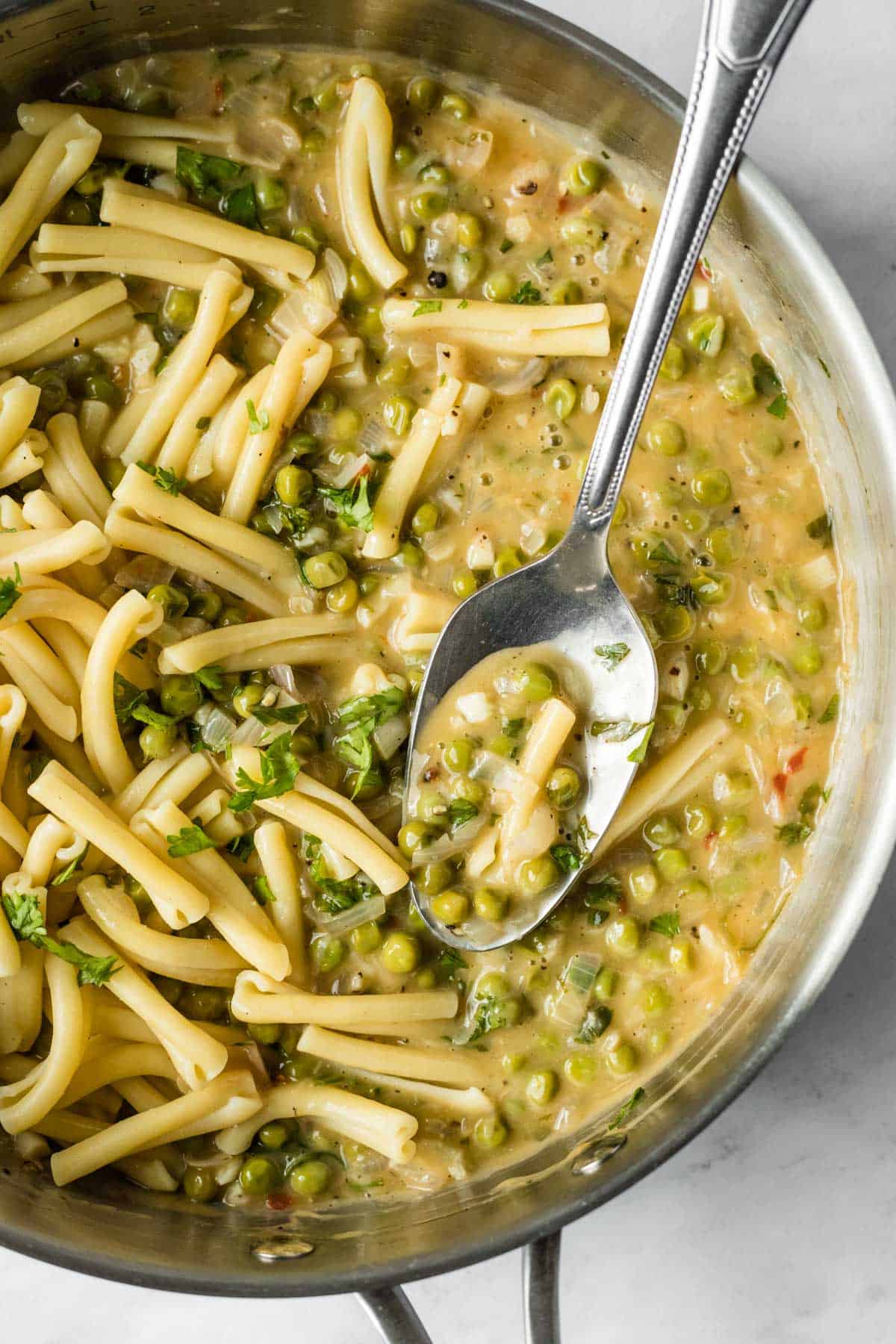
Jump to:
Why You'll Love It
There's just something about the brightness of white wine paired with garlic, butter, and a hint of sweetness from shallots (or onion). If you're a fan of lemon-based sauces, you're going to LOVE white wine sauce.
It's tart, fresh, bright, exciting, and somehow tastes much more complex than it actually is. Think of white wine pasta sauce almost like a lemon pasta sauce, but minus the lemon flavor.
This dish is a breeze to make and pairs well with a variety of vegetables and pastas. Serve with garlic bread and a salad, and prepare to swoon with every bite!
Which white wine is best for pasta sauce?
For this recipe you want a crisp, dry white wine with a decent amount of acidity. Something like a Pinot Grigio, Sauvignon Blanc, light Chardonnay, un-oaked Chardonnay, or good quality white table wine.
When you take a sip, the wine should strike you as bright, tart, and refreshing, not sweet or heavy. The wine's natural acidity is what gives the sauce such great flavor and contrasts with heavier ingredients like butter and cream.
How to Find Vegan Wines
Since this is a vegan blog, you know I also have tips to help you for find vegan wines! In case you didn't know, unfortunately, the wine industry is one of the least vegan-friendly when it comes to alcoholic beverages.
Don't get me wrong, there are many vegan wines available, but some wineries still use animal products to filter and clarify the wines.
- Common non-vegan fining agents: isinglass (from fish bladders), casein (from milk), gelatin (animal by-product), and albumen (from eggs).
- Common vegan-friendly fining agents: charcoal, silica, bentonite clay.
The challenge comes when you're at the store, browsing wines, and then realize most labels don't indicate whether the wine is vegan or not. Generally, you're more likely to see "vegan" on the labels of organic wines. So that's always an easy place to start.
You can also pull up Barnivore.com on your phone and type in the name of the wine you're interested in. Word of warning - the website can be clunky to use.
I recently found this fantastic post over at thetreehugger.com: Vegan Wines You Can Find AND Afford!
I love Jessica's article because she names common white wines you'll find in almost any store (and they work in this recipe), such as:
- Decoy - Sauvignon Blanc
- Bogle - Sauvignon Blanc & Chardonnay
- Kris - Pinot Grigio
- Natura - Sauvignon Blanc & Chardonnay
- Layer Cake - Sauvignon Blanc and Chardonnay
- Little Black Dress - Pinot Grigio & Chardonnay
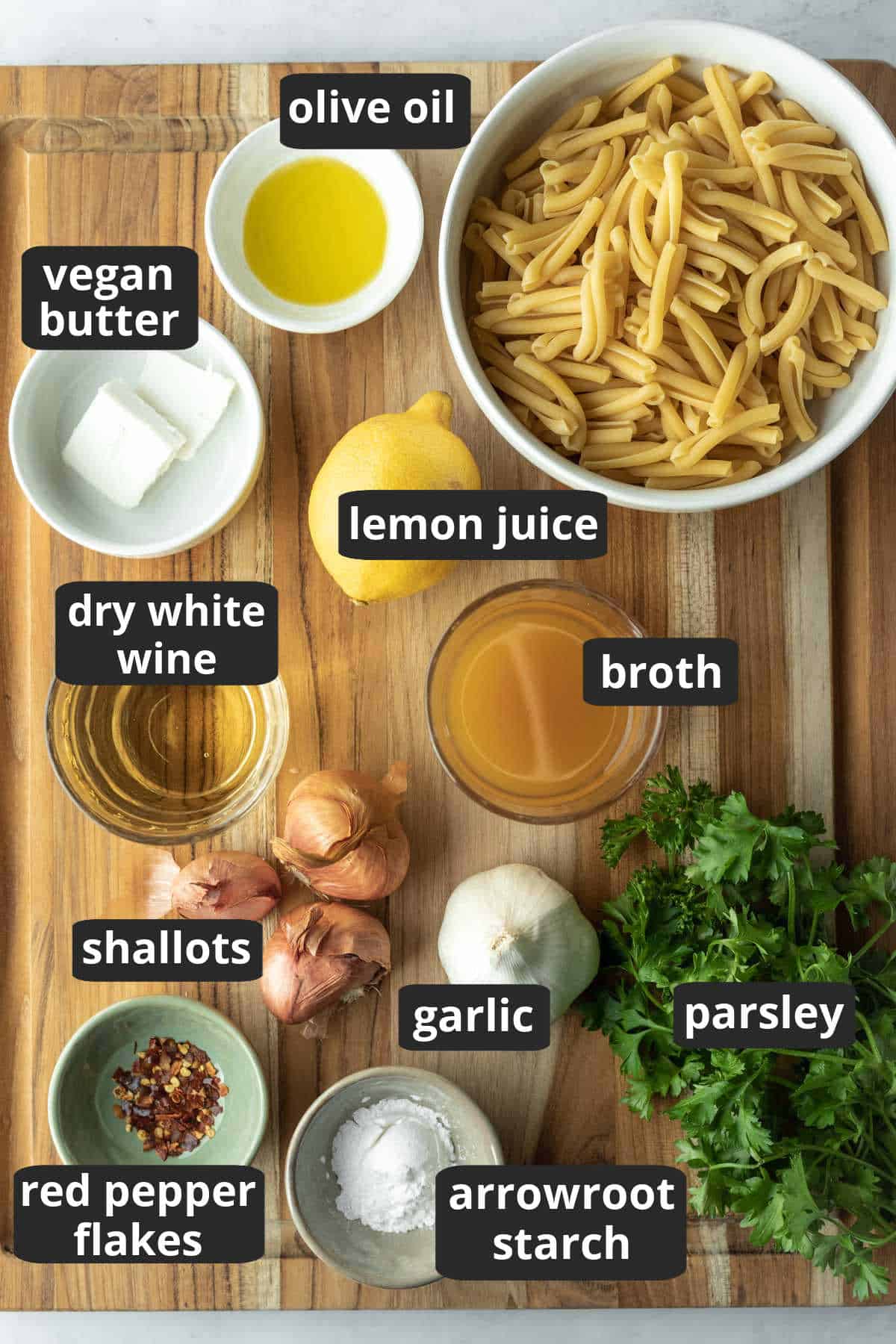
Ingredients and Substitutions
Find amounts and full instructions in the recipe card below. Here are a few ingredient tips.
- shallots and garlic - shallots are more mild than onion and are a classic ingredient in white wine sauce. Feel free to use yellow or sweet onion if that's easier.
- butter and oil - since I'm vegan, obviously I used vegan butter. Miyoko's cultured European-style butter is my top choice. Combining it with a tablespoon of oil increases the smoke point and improves the texture and mouthfeel of the sauce. These fats are important for balancing the acidity of the white wine and carrying the flavors throughout the sauce.
- white wine - as discussed above, for this sauce you want a crisp, dry white wine with a decent amount of acidity. Something like a pinot grigio, sauvignon blanc, light chardonnay, or quality white table wine. When you take a sip it should strike you as bright, tart, and refreshing, not sweet.
- arrowroot and vegetable broth - feel free to use corn starch instead; this slurry thickens and enhances the savoriness of the sauce while keeping it gluten-free.
- lemon juice - just a squeeze added before serving gives the sauce an extra layer of freshness and flavor.
- curly parsley - not only is fresh parsley beautiful and healthy, it lends a fresh herb flavor that doesn't overpower.
- Parmesan - I used Violife's Just Like Parm. I added a fairly small amount just to give the sauce a bit more richness and a creamy element. Feel free to omit if you don't have access to vegan Parm.
- crushed red pepper and black pepper
Want to save this recipe? 📩
Keep an eye out for more delicious recipes. Unsubscribe anytime.
How to Make White Wine Pasta
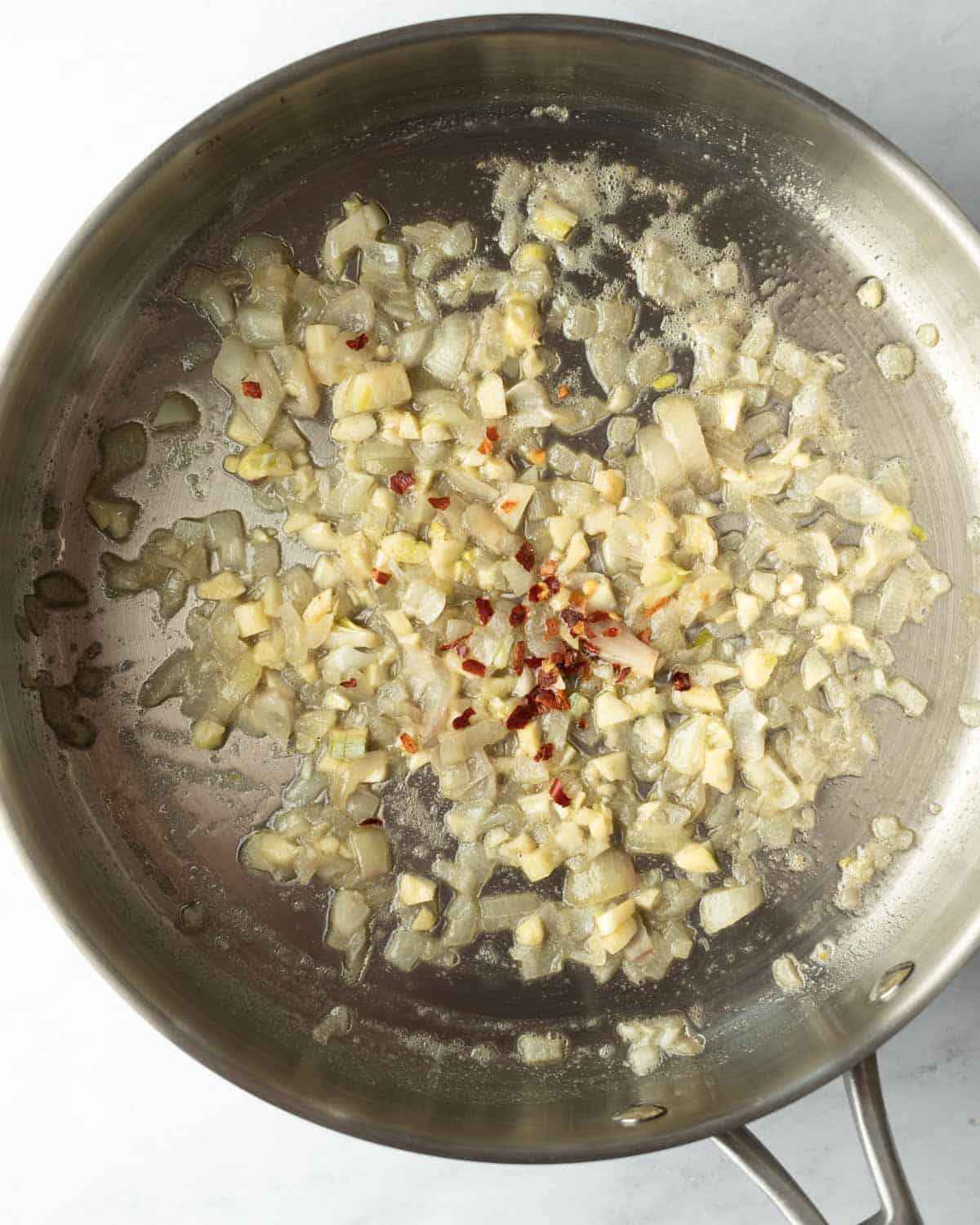
Combine 2 tablespoons vegan butter and 1 tablespoon olive oil over medium-low heat. Gently saute the shallots and garlic for about 4 minutes, stirring occasionally. Season with a pinch of red pepper flakes.
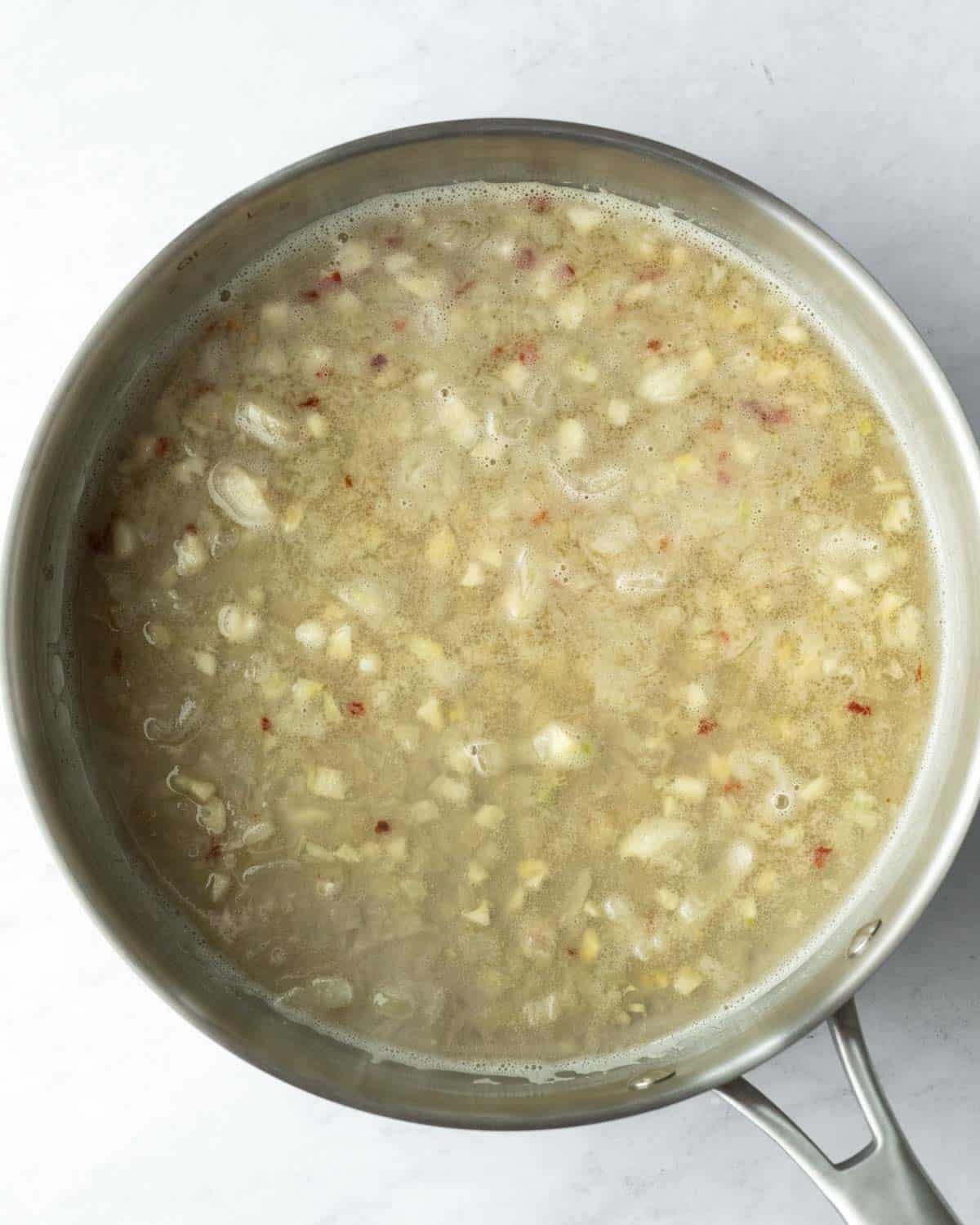
Add the wine to the pan and stir. Bring to a simmer and cook for about 3 minutes or until slightly reduced. In a small bowl combine the broth and starch. Add this slurry to the pan, and cook until the sauce begins to thicken, about 2 minutes.

Add the frozen peas, if using, and cook until the peas are hot, 3 to 4 minutes. Reduce heat to low and add the parsley, lemon juice, salt, and black pepper. Use a microplane to grate the vegan Parmesan into the pan, and stir until melted and creamy.
If desired add the remaining tablespoon of butter, and reserved pasta water, and stir again.
Toss the pasta with the sauce. Taste and adjust flavors as desired, adding more cheese, lemon, salt, or pepper. Garnish with extra parsley, Parmesan, and black pepper, and serve hot.

Variations
White wine pasta sauce can be paired with any type of pasta, veggies, and protein you enjoy. We like to keep the pasta simple with a green vegetable like peas, broccoli rice or florets, baby spinach, or chopped kale.
But it's also fantastic with sautéed mushrooms (pictured below). Their earthy and meaty flavor paired with the brightness of the sauce is a match made in heaven! Here are some ideas:
- zucchini or yellow squash
- asparagus
- mushrooms
- frozen peas (included in the recipe)
- Tuscan kale
- baby spinach
- small broccoli or cauliflower florets
- halved cherry tomatoes
Make your vegan white wine pasta more filling with cooked white beans, chickpeas, shredded seitan, or steamed tofu or tempeh.
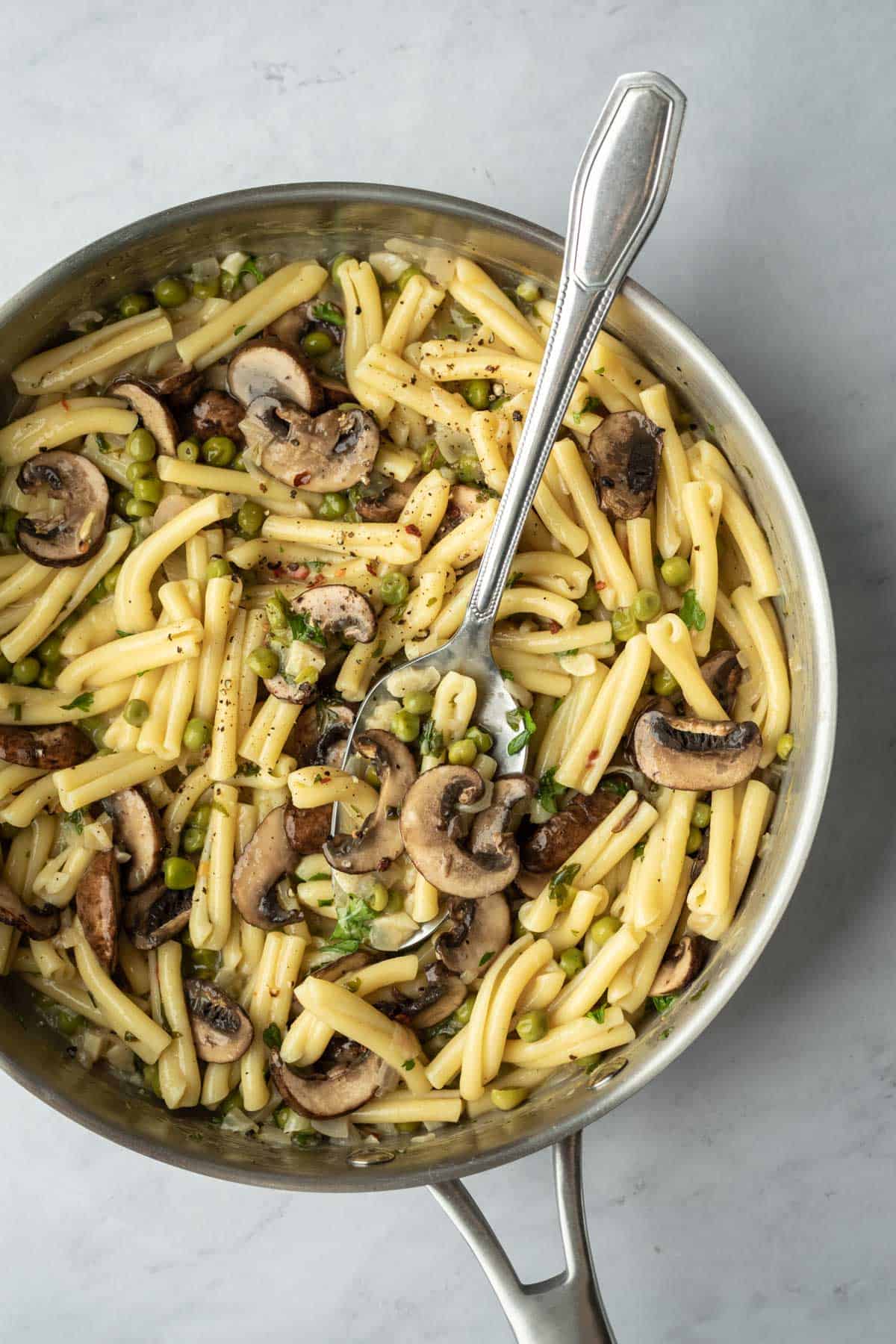
Batch Size
The recipe makes just enough sauce for 8 ounces of dry pasta. So if you're cooking for more than 2 to 3 people or want to prepare a full 16-ounce package of pasta, double the amounts for the sauce ingredients.
Recipe FAQs
Yes, this recipe is gluten-free. While some creamy sauces are thickened with flour, this one uses arrowroot (or corn starch) to add a light creaminess to the finished sauce.
Definitely. But good luck not eating it all right away!
Store leftover sauce and pasta in the refrigerator for up to 5 days. Reheat on the stovetop or in the microwave.
More Easy Pasta Recipes
I hope you love this white wine pasta sauce as much as we do! If you try the recipe be sure to comment below and let us know!
Recipe
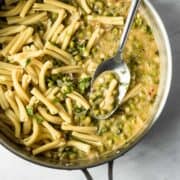
White Wine Pasta Sauce (Vegan & Gluten-Free)
Equipment
Ingredients
- 8 ounces dry pasta of choice
- 1 Tablespoon olive oil
- 3 Tablespoons vegan butter, divided
- 2 large shallots, finely chopped - about ½ cup
- 4 medium cloves garlic, minced
- pinch of crushed red pepper flakes
- 1 cup dry white wine - such as Pinot Grigio, Sauvignon Blanc, or light Chardonnay; see post above for more information
- ¾ cup frozen peas, optional - see Notes for other veggie ideas
- ½ cup vegetable broth
- 2 teaspoons arrowroot starch - sub corn starch if needed
- ¼ cup chopped fresh curly parsley
- 1 Tablespoon lemon juice
- ¾ teaspoon fine sea salt
- black pepper
- .5 to 1 ounce vegan Parmesan, optional - I used Violife Just Like Parm
Instructions
- Cook the pasta in salted water according to package instructions. Reserve about ⅓ cup cooking water, and drain pasta in a colander.
- Preheat a large saute pan over medium-low heat, and add 1 tablespoon oil and 2 tablespoon butter. Gently saute the shallots and garlic for about 4 minutes, stirring occasionally. Season with a pinch of red pepper flakes.
- In a small bowl whisk together the broth and starch until dissolved. Set aside.
- Add the wine to the pan and stir. Bring to a simmer and cook for about 3 minutes or until slightly reduced. Add the starch slurry, and cook until the sauce begins to thicken, about 2 minutes. Add the frozen peas, if using, and cook until the peas are hot, 3 to 4 minutes.
- Reduce heat to low and add the parsley, lemon, ¾ teaspoon fine sea salt, and black pepper. Grate the vegan Parmesan into the pan (I used approx. ½ serving of cheese - not much), and stir until melted and creamy. Add the remaining tablespoon of butter and a splash of reserved pasta water, and stir again. Remove from heat.
- Toss the pasta with the sauce. Taste and adjust flavors as desired, adding more cheese, lemon, salt, or pepper. Garnish with extra parsley, Parmesan, and black pepper, and serve hot.
Notes
Estimated Nutrition (per serving)
Nutrition information is an estimate and will vary depending on the exact amounts and specific products and ingredients used.


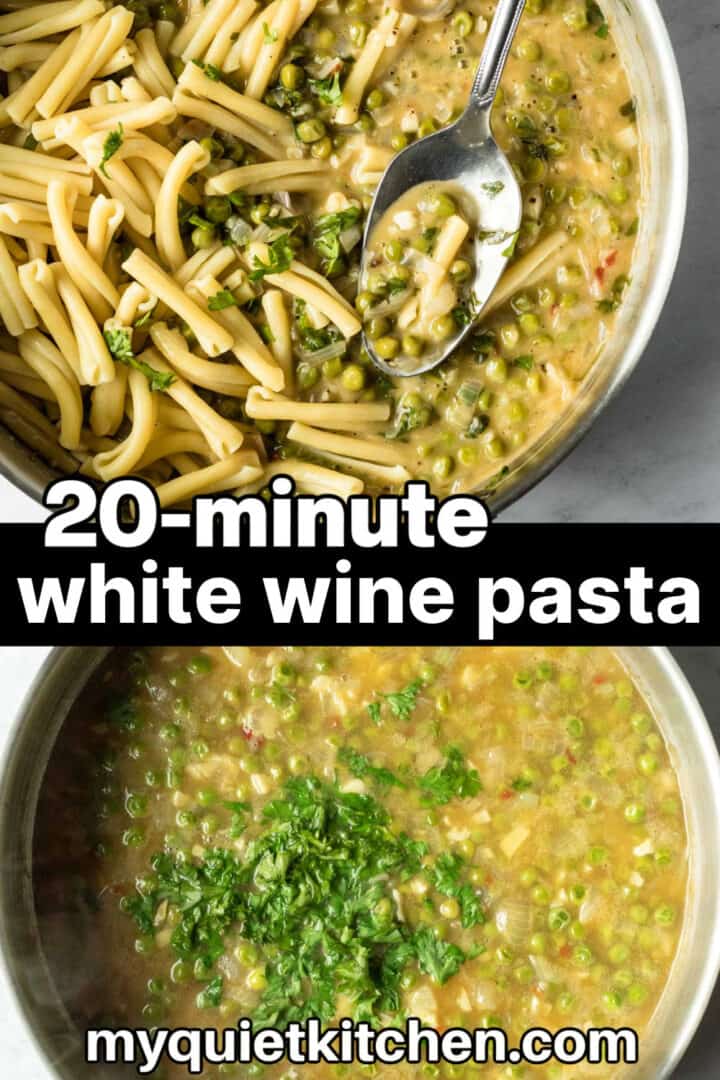
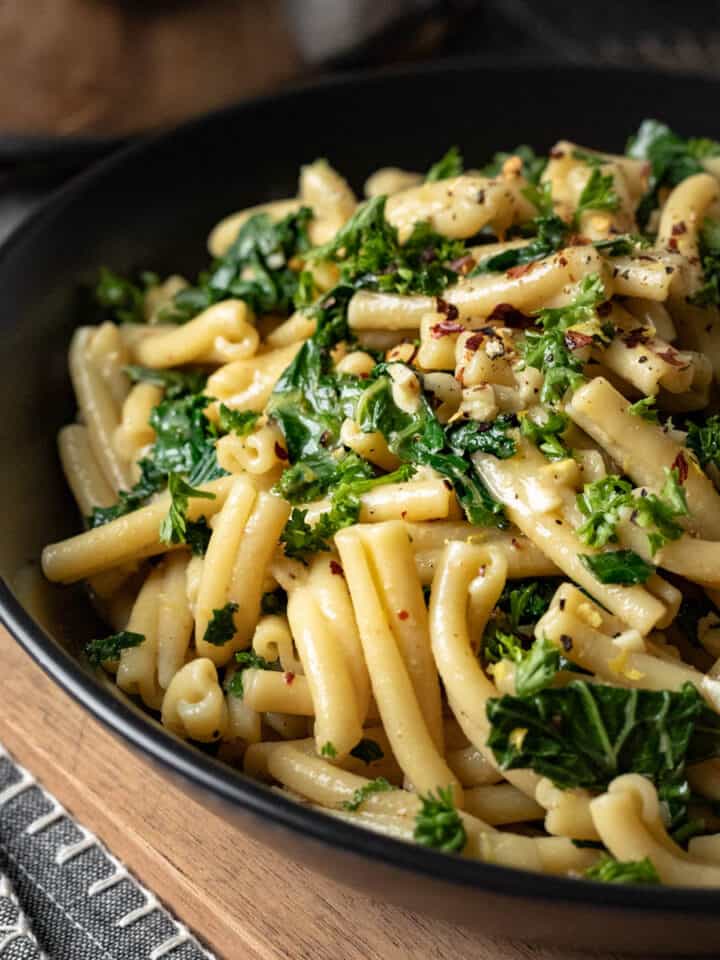
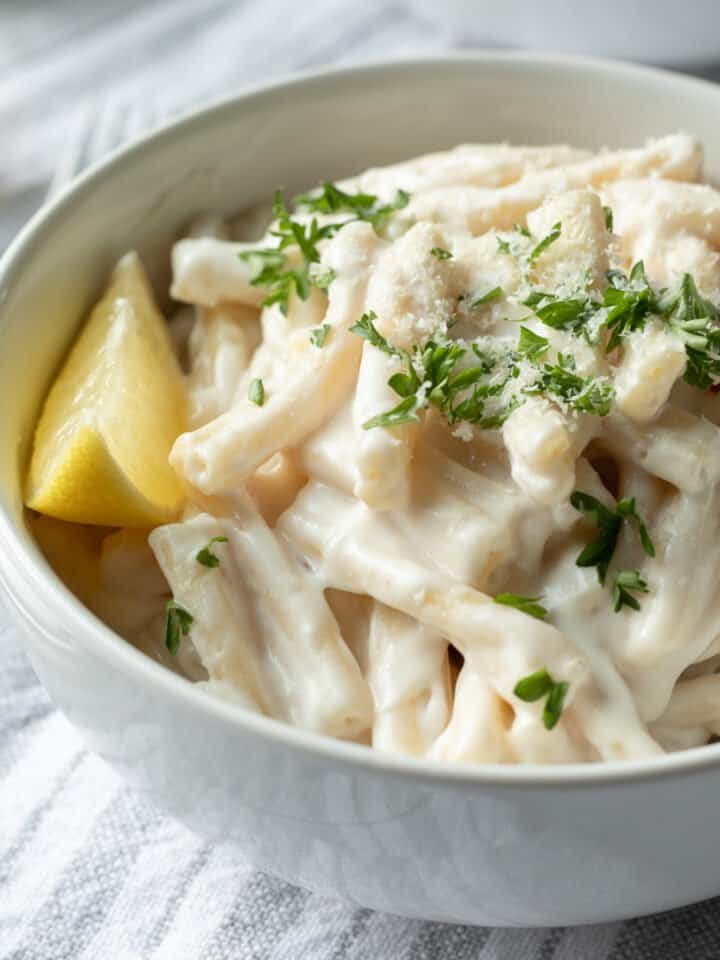
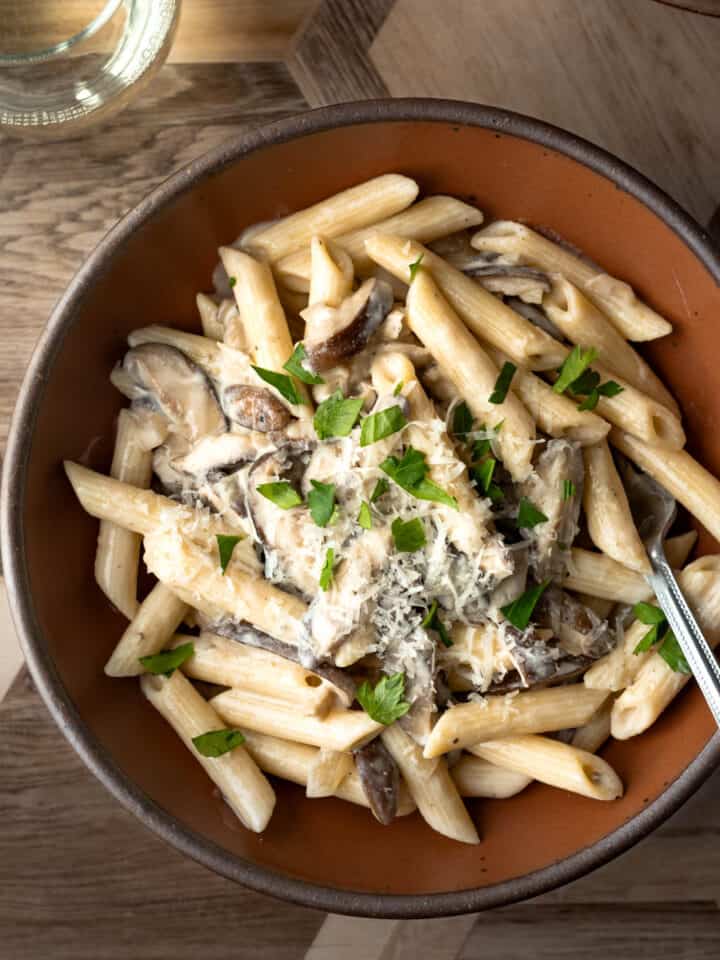

Kris says
This was delicious! Definitely a keeper for my go-to recipe book. Thank you!
Mary says
What is the name of the pasta shown in this dish? I had this same dish in Italy last week, minus the peas with a bit of kale…..delicious!
Lori says
Hi Mary,
This is casarecce. We love this pasta! Here's another recipe featuring it: https://myquietkitchen.com/casarecce-pasta-with-butter/
Kristin Neubauer says
Wonderful! I’m no cook, but this was easy to follow and turned out beautifully. I couldn’t use vegan butter or parm because all oils except olive oil cause me migraines..:: and most vegan butters/ cheeses are made with various oils. So I used Olive oil in place of butter. I mixed in steamed broccoli. Love how the sauce soaked into every piece of pasta and broccoli. Such a light and crisp flavor. Thanks, Lori!
Carla says
Delicious!! Made this last night right after you shared it on Facebook. Added cannellini beans and served with roasted Brussels sprouts. Will 100% make again and again.
daisy says
This looks wonderful! I have had no luck in finding veggie broth without tomatoes in it. I can't have any nightshades, as it affects my skin. If I get around to making my own broth, I'll give this a go since I can no longer enjoy tomato sauce on my pasta. Thank you!
Lori says
Hi Daisy,
The broth plays a pretty small role here, so I would just go for it, if I were you! 😀 I was already thinking about trying it with a bit of plain soy milk instead of the broth, to give it a creamier element. But honestly, I think you could simply use water - or even better, the pasta water. Hope you enjoy it!